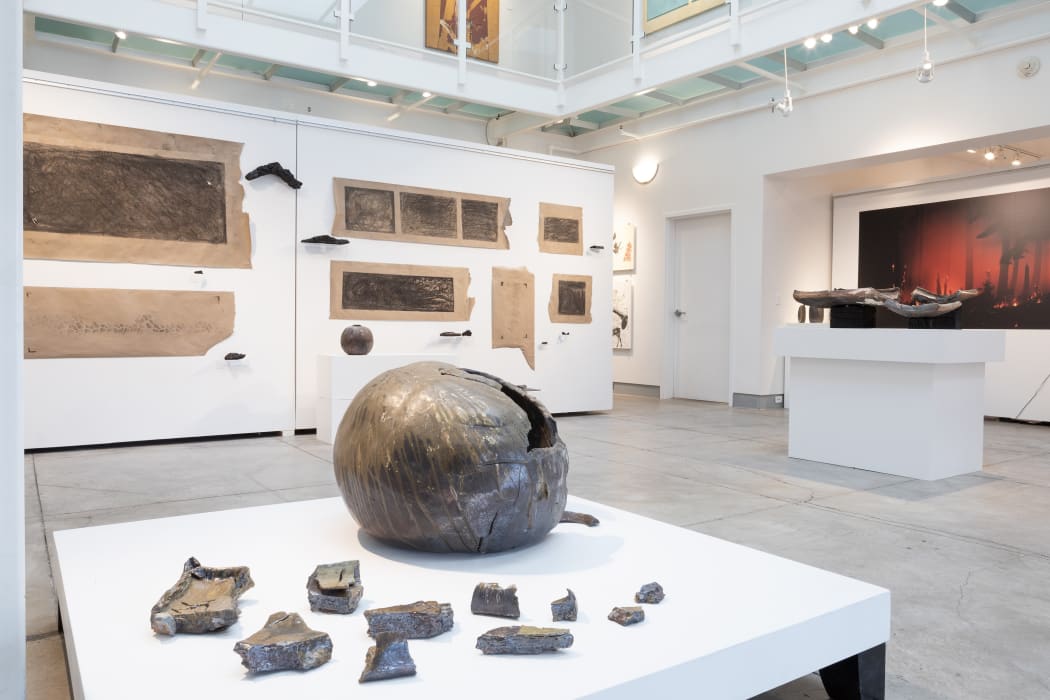
Exhibition Statement
AVI FARBER
Markings from Fire is a collection of moments, reflections, stories, sketches, sculptures, and interactions from my relationship working with fire as a ceramic artist and wildland firefighter. The exhibition comprises large wood-fired ceramic sculptures, wildfire charcoal drawings, a series of assemblages composed of ceramic fused with aluminum, and 3-D printed ceramic flasks glazed with ash from wildfires. This body of work is, at its simplest, an elemental exploration—an exploration of the materials that make up the landscapes surrounding my studio, of my relationship with the land, and the transformative power of fire and time.
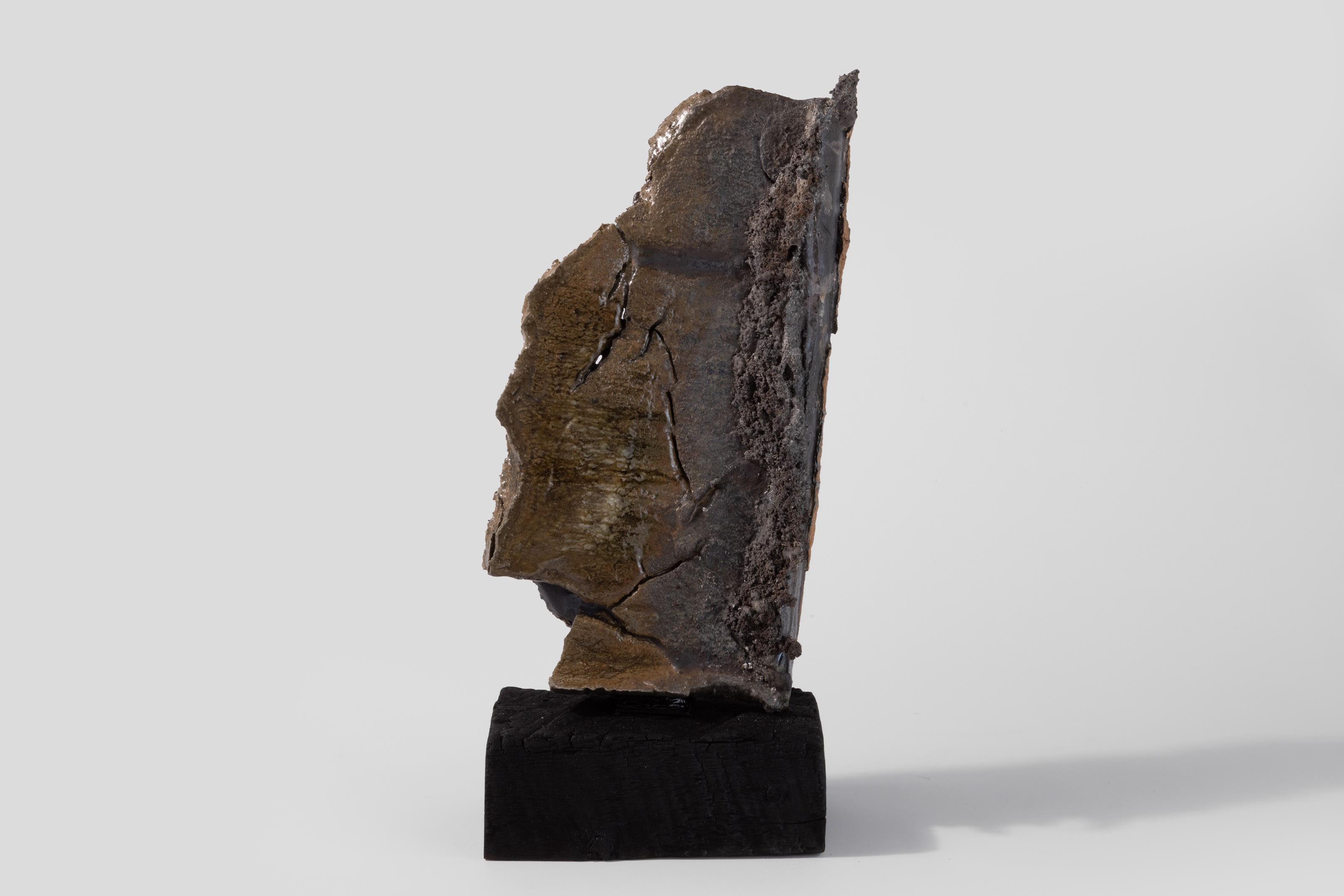
2.5 Billion Years Ago, 2025. Wood-fired ceramic, black stoneware dug near Abiquiú, NM, between 72 and 100 million years old; Ojo Caliente feldspar mineral inclusions approximately 2.5 billion years old; Ponderosa Pine ash; charred beam base, 21 x 9 x 5 1/2 in (53.3 x 22.9 x 14 cm).
The depth of this work comes from the process. When you first walk into the exhibition, you will be greeted by large tectonic sculptures. These ceramic panels are made with clays and minerals that I collect around northern New Mexico. I sculpt these clays into slabs and allow them to move with the sun and the cold northern New Mexico nights as they settle. I want them to crack, open up, have a voice. I then layer their surfaces with a slurry of feldspathic rocks I collected and ball-milled into white glaze. Once dry, these panels are fired with wood for five days and nights in a kiln we built in a valley west of Taos, NM. The kilns reach over 2300 degrees Fahrenheit, melting the wood ash and rock glazes, traversing the surfaces with fire, and adding another layer of depth to these pieces.
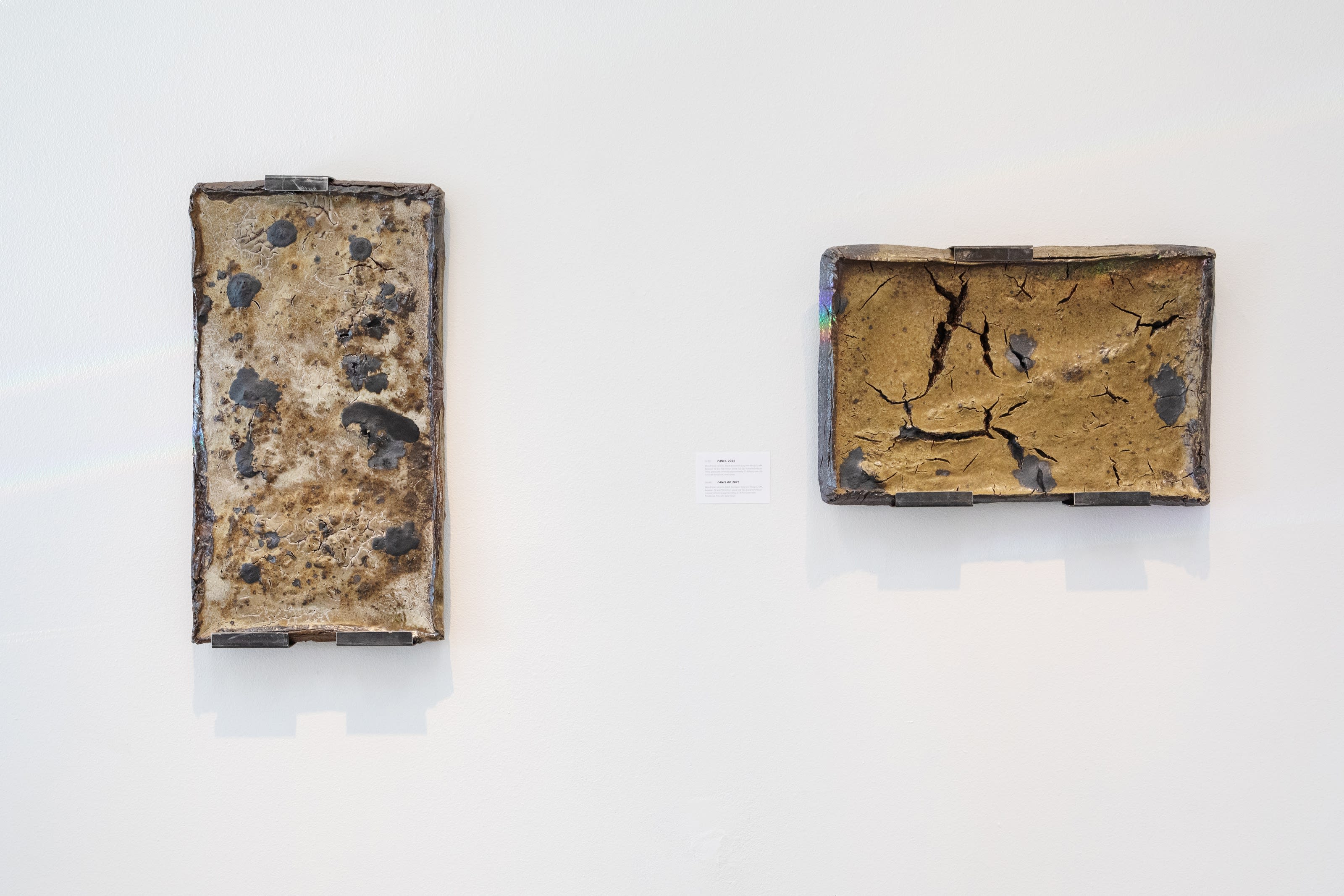
Left: PANEL, 2025. Wood-fired ceramic, black stoneware dug near Abiquiú, NM, between 72 and 100 million years old; Ojo Caliente feldspar Shino glaze with minerals approximately 2.5 billion years old; iron melt inclusions; steel cleats, 36 x 21 x 2 in (91.4 x 53.3 x 5.1 cm).
Right: PANEL 00, 2025. Wood-fired ceramic, black stoneware dug near Abiquiú, NM, between 72 and 100 million years old; Ojo Caliente feldspar mineral inclusions approximately 2.5 billion years old; Ponderosa Pine ash; steel cleats, 20 x 31 x 3 in (50.8 x 78.7 x 7.6 cm).
Can you fathom 100 million years? That’s the age of the black clay that I dig near Abiquiú, NM, that makes up the ceramic panels. Once part of the Cretaceous seaway that covered a large part of western North America, it resided there until it was uplifted into the Rocky Mountains, and I brought it back to my studio. How about 2.5 billion years? That’s the age of the feldspars collected around Ojo Caliente, NM, that form the glazes. I really can’t fathom geologic time, but the fact that I can even work with these materials is humbling, rewarding, and full of value.
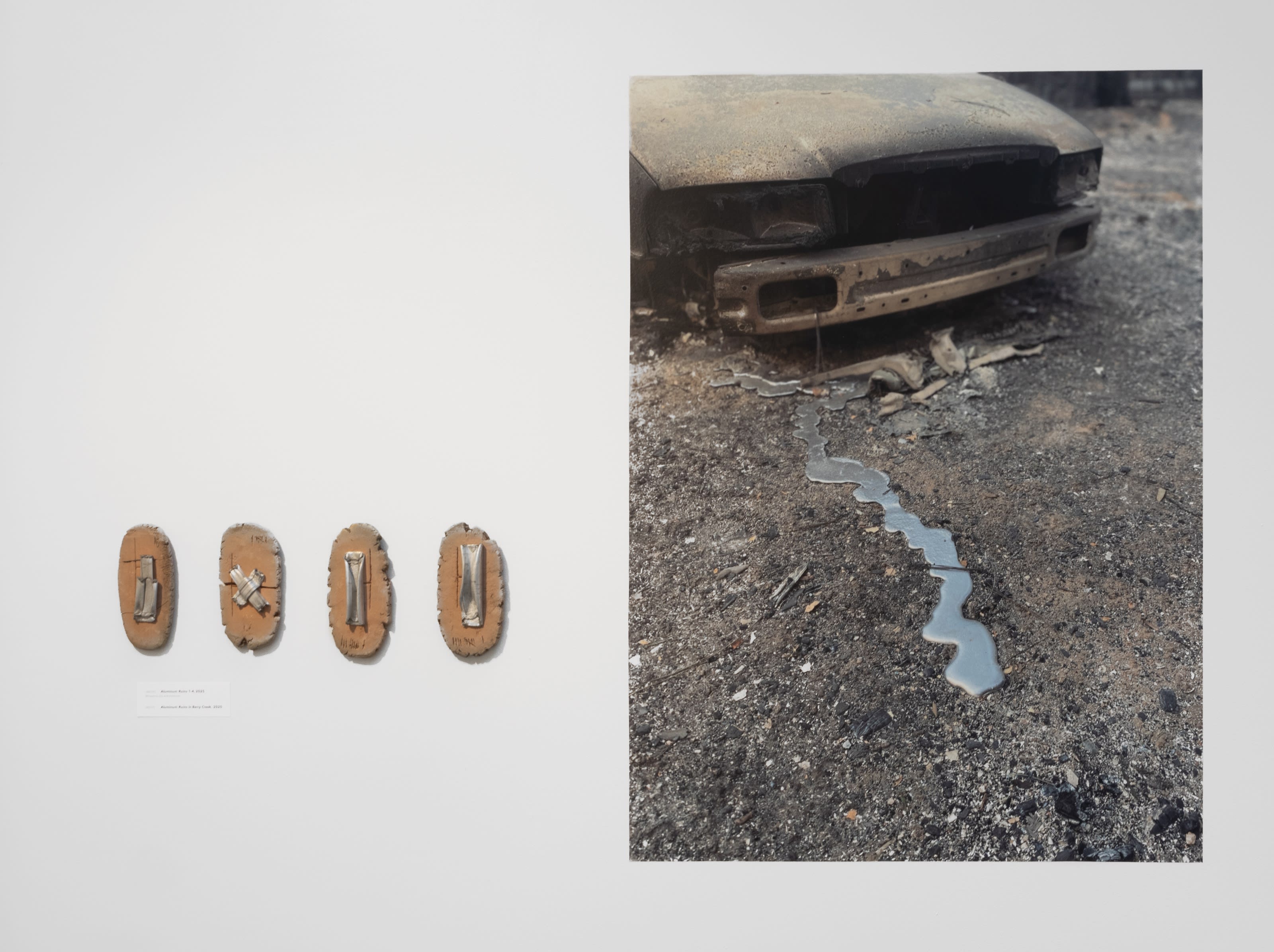
Left: Aluminum Ruins 001–004, 2025. Micaceous clay and aluminum, 8 x 4 x 1 in (20.3 x 10.2 x 2.5 cm).
Right: Photo of Berry Creek Fire ruins, courtesy of the artist
When you round the corner of the exhibition, you will see a photo of melted aluminum flowing out of a car. I captured this moment while on assignment photographing the town of Berry Creek, CA, that was overrun by the North Complex Fire (2020). I was one of the first people to walk through this ruin as I documented it—an experience that continues to impact me. The Aluminum Ruins assemblages are a reformulation of this moment at Berry Creek. They offer a reflection of the brute force of nature, the toxicity of our dwellings, and the markings of loss. When I left Berry Creek, I drove north through the darkened Plumas National Forest that was aglow with fire. I stopped for a moment of quiet and scooped some ash into a bag. Back in my studio, I mixed this ash into a glaze and used it to give the 3-D printed vessels another layer of meaning. Made in 2020, these vessels are some of my early experiments in ceramic 3-D printing.
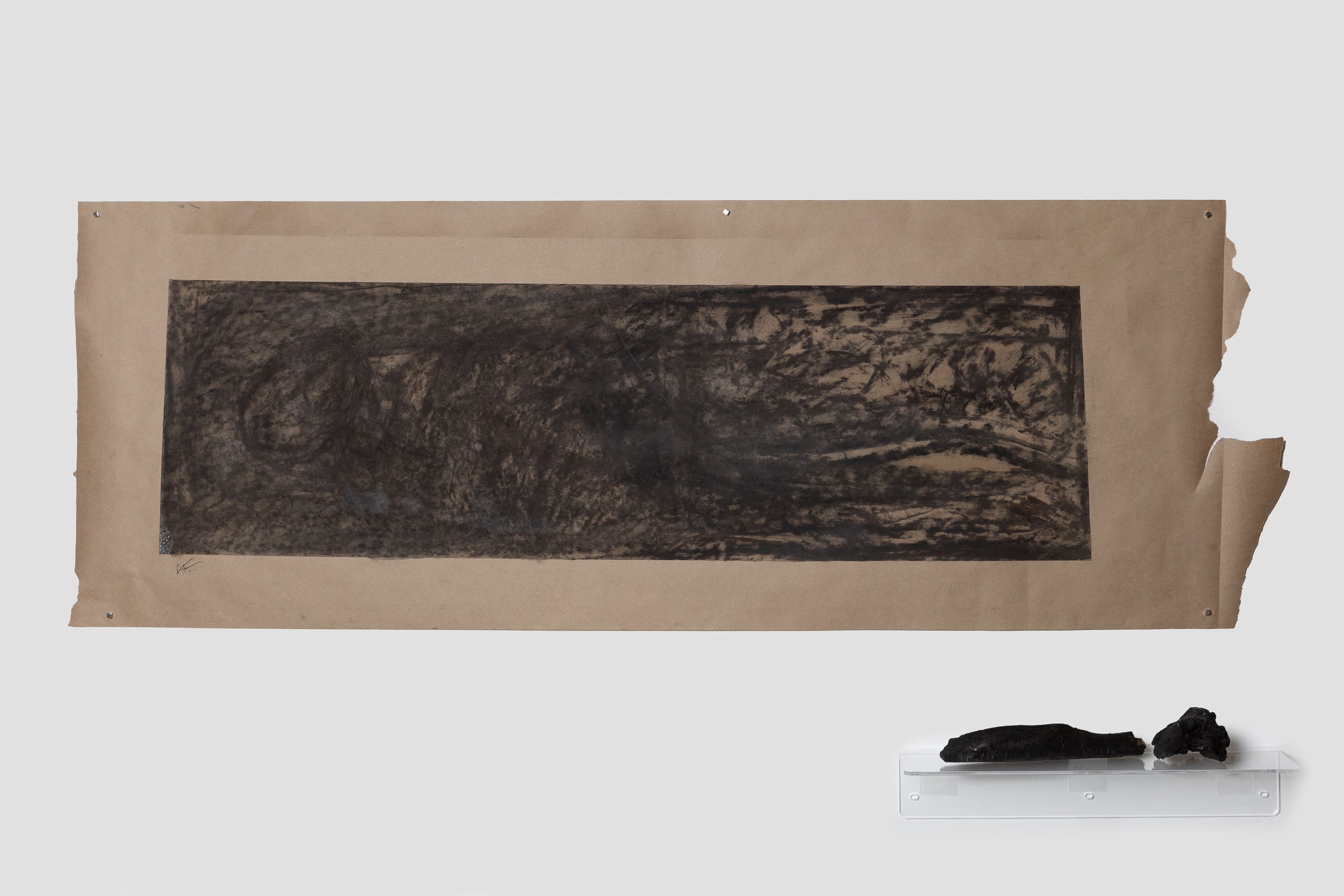
Markings from Fire – American Creek/Hermits Peak Sketch 004, 2025. Wildfire charcoal on paper and charred tree branch, 18 x 48 in (45.7 x 121.9 cm).
Next, the drawings are made with charcoal that I collected in the American Creek Rx fire and Hermits Peak burn scars. They are both playful and reflective. Part of my practice requires thinking about my time around fire, and these drawings provide a space for me to channel the energy and the whisperings of my subconscious onto paper from the many years I spent on the edges of wildfires. They are loose reflections on the impressions we make on these landscapes, our use of fire, and our attempts to control it. Moving the charcoal across the paper allows me to bring fire’s more abstract impacts to the surface, both personally and collectively.
Fire is a powerful force that brings destruction and discomfort as well as beauty and renewal. My work seeks to explore this duality. I connect with fire as a friend and cautious collaborator in order to better understand our relationship with fire in the landscape and the modern world. All of the vessels in this show carry fire in some way—either directly shaped by fire in their formation, or through an interaction with material transformed by fire. I am offering a wide-ranging collection of markings from my relationship with fire—from fire in the kiln and the landscape, as a spirit, and as a force of nature.
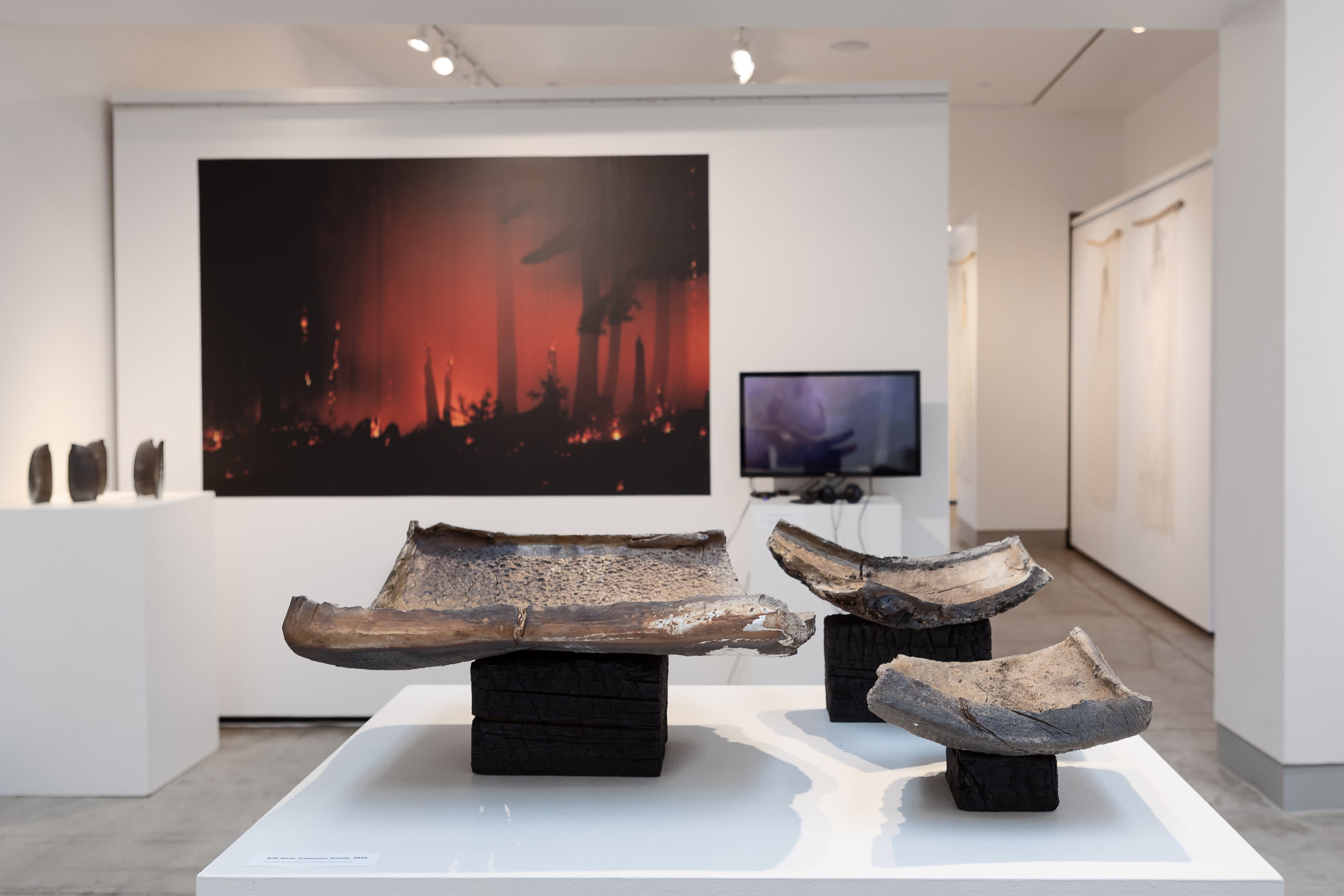
Markings from Fire, installation view.
Foreground: Split Stone, Cretaceous Seaway, 2025. New Mexico stoneware and charred beam base, dimensions variable.
Background, left: Encoded Stone Vessel, Berry Creek 1–5, 2021. 3-D printed ceramic and wildfire ash glaze, 9 x 4 x 1 in (22.9 x 10.2 x 2.5 cm).
Background, middle: at night, with the trees, 2020. Digital photo.
Curatorial Statement
CARINA EVANGELISTA
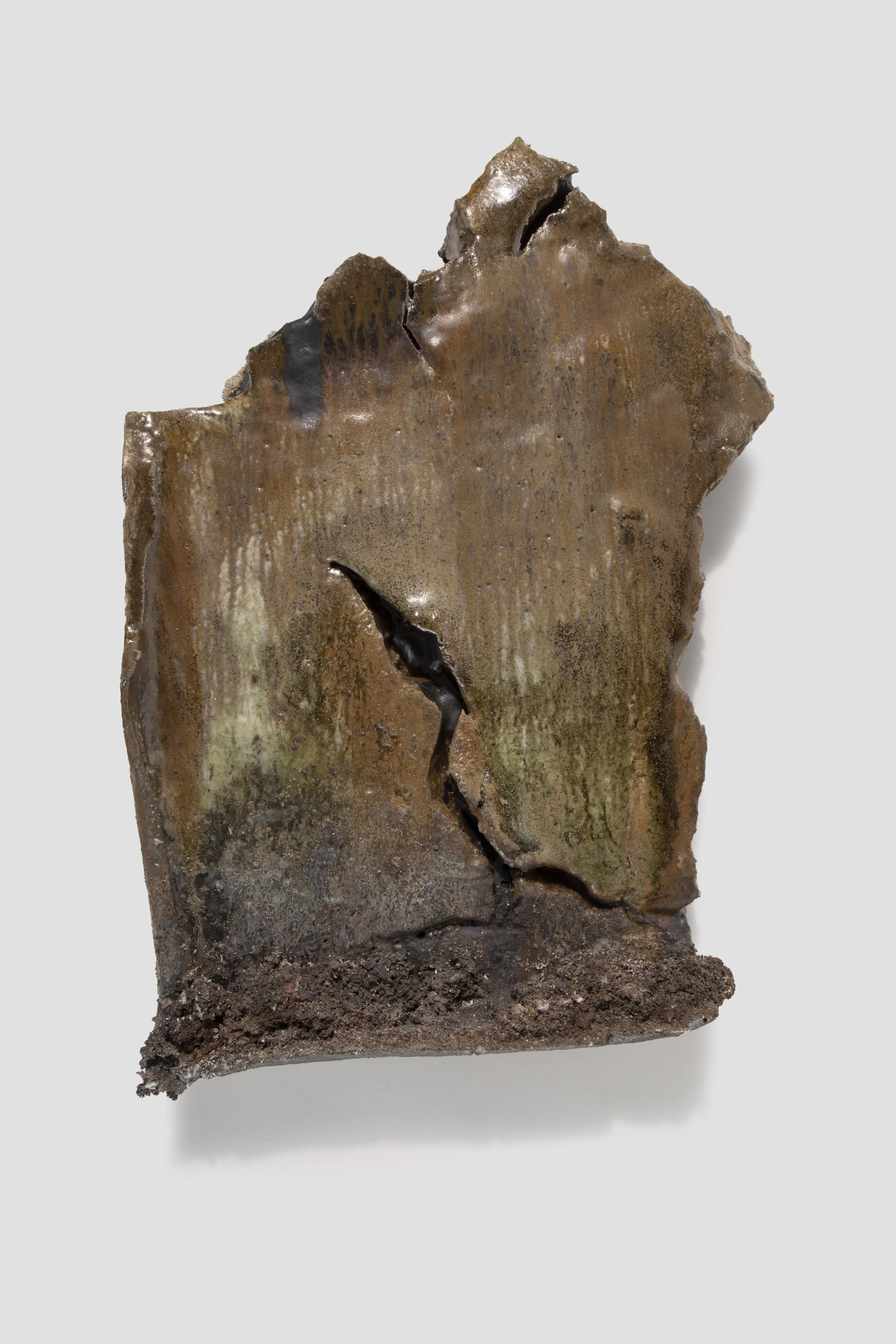
PANEL 030, 2025. Wood-fired ceramic, black stoneware dug near Abiquiú, NM, between 72 and 100 million years old; Ojo Caliente feldspar Shino glaze with minerals approximately 2.5 billion years old; iron melt inclusions; steel cleats, 19 x 13 x 2 in (48.3 x 33 x 5.1 cm).
Glossy chunks with angular silhouettes. A large orb with a finish that feels like rusting metal to both the eye and the touch; its split bottom the nest for fragments of the orb’s lip. Large panels that bear lines like those of old maps or small dark pools of mineral deposits that feel like volcanoes. Thin ridged flasks with a black matte finish standing in a row—simultaneously fragile and stalwart. Vertically mounted pieces that call to mind mountains, buttes, and geographical rifts. Charred wood beams as plinths. Scrolls with abstract drawings in charcoal. Strips of melted aluminum on small micaceous clay tablets. These are the many “vessels that carry fire in some way” for Avi Farber, who refers to this exhibition as “a collection of markings” shaped by his “relationship with fire—from the kiln, in the landscape, as a spirit, and as a force of nature.”
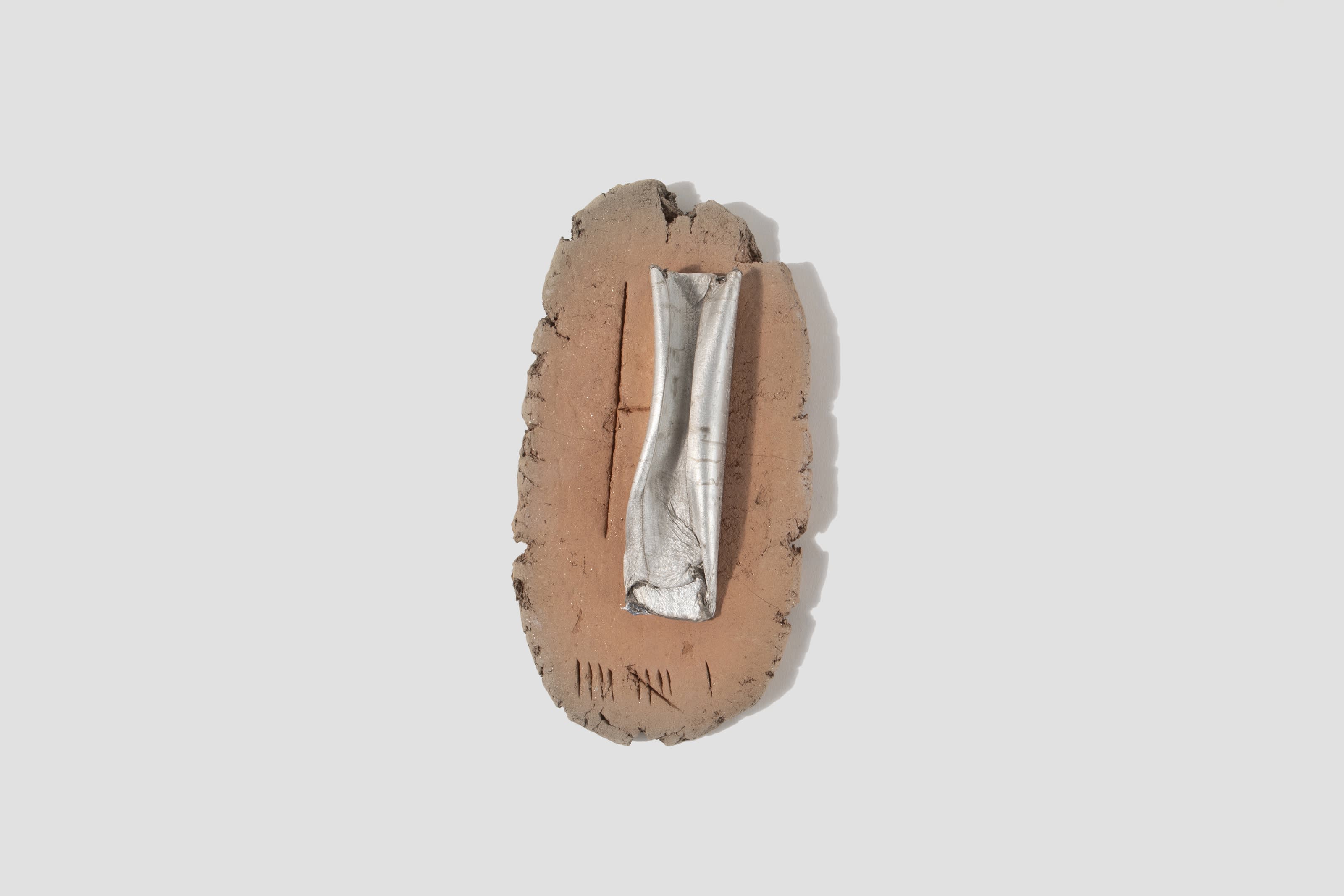
Aluminum Ruins 004, 2025. Micaceous clay and aluminum, 8 x 4 x 1 in (20.3 x 10.2 x 2.5 cm).
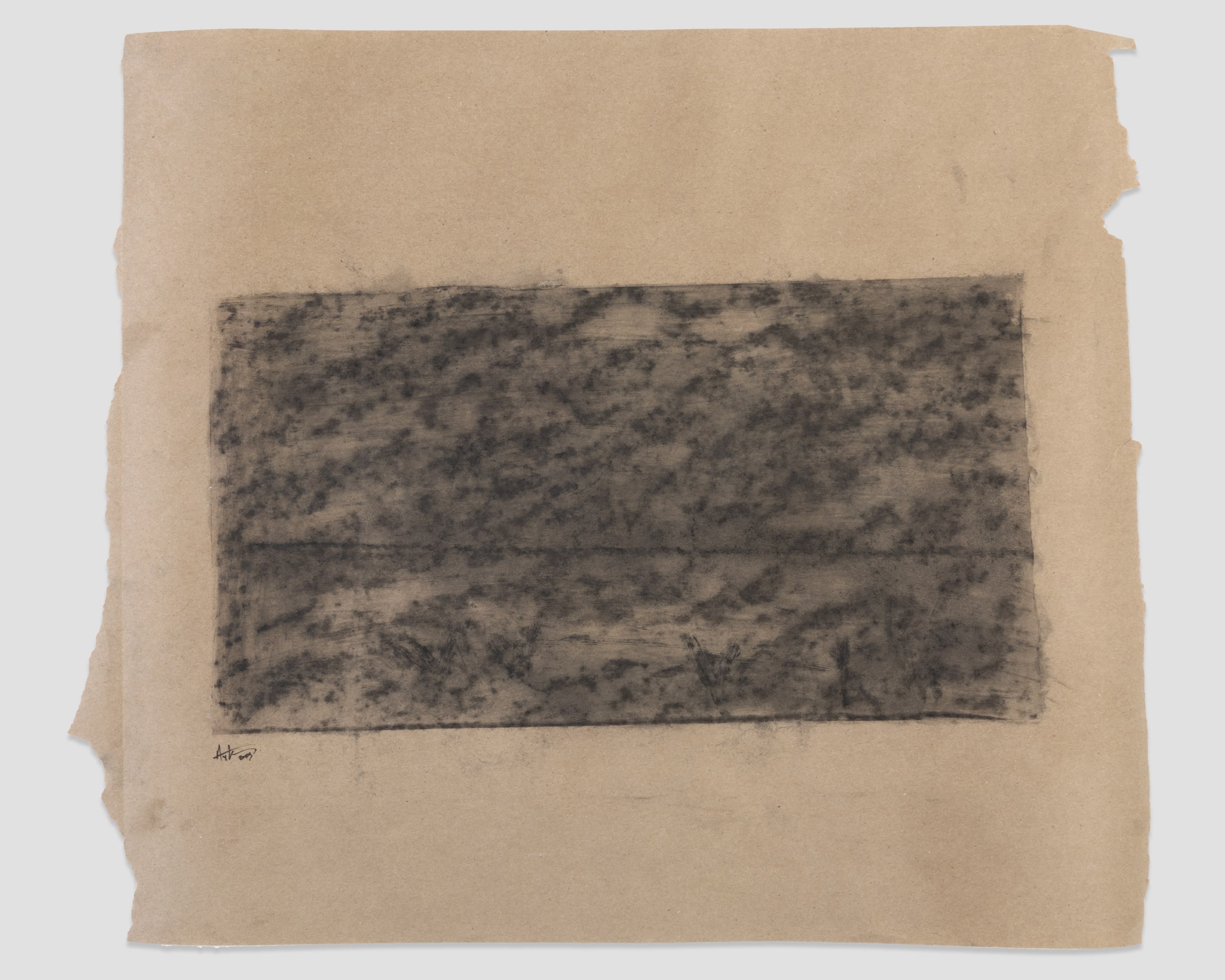
Markings from Fire – American Creek/Hermits Peak Horizon 002, 2025. Wildfire charcoal on paper and charred tree branch, 18 x 19 1/2 in (45.7 x 49.5 cm).
The rendering of change in the chemical composition of just about anything subjected to heat applies to food, temper, love, or lust. Such change can be found achingly beautiful in the transformation that happens in flour, salt, and water that turns to bread; in sand that turns to glass; in these ceramic pieces Farber threw in the fire. A former wildland firefighter, Farber himself seems forged in fire. As a “student of fire,” he continues to form kinship with it in order to craft beauty with it. He watches it when he fights it. He finds poetry even when powerless in the face of its power, writing of “fireflies” that burning trees send flying into the blackened sky. He finds inspiration in a rivulet of melted aluminum found underneath a vehicle in the ruins of a wildfire—as if the car bled liquid mercury. He exorcises the intensity of being witness to its force by creating small squares or abstract panoramas of soot, tenderly shaded or vigorously scraped onto thin sheets of brown paper with burnt tree branches from the American Creek or Hermits Peak Fire. He glazes 3-D printed clay flasks with ash collected from the North Complex Fire in California to create conditions for “a collision of the hi-tech and the wild” and for “knitting together the ancient with the future.”
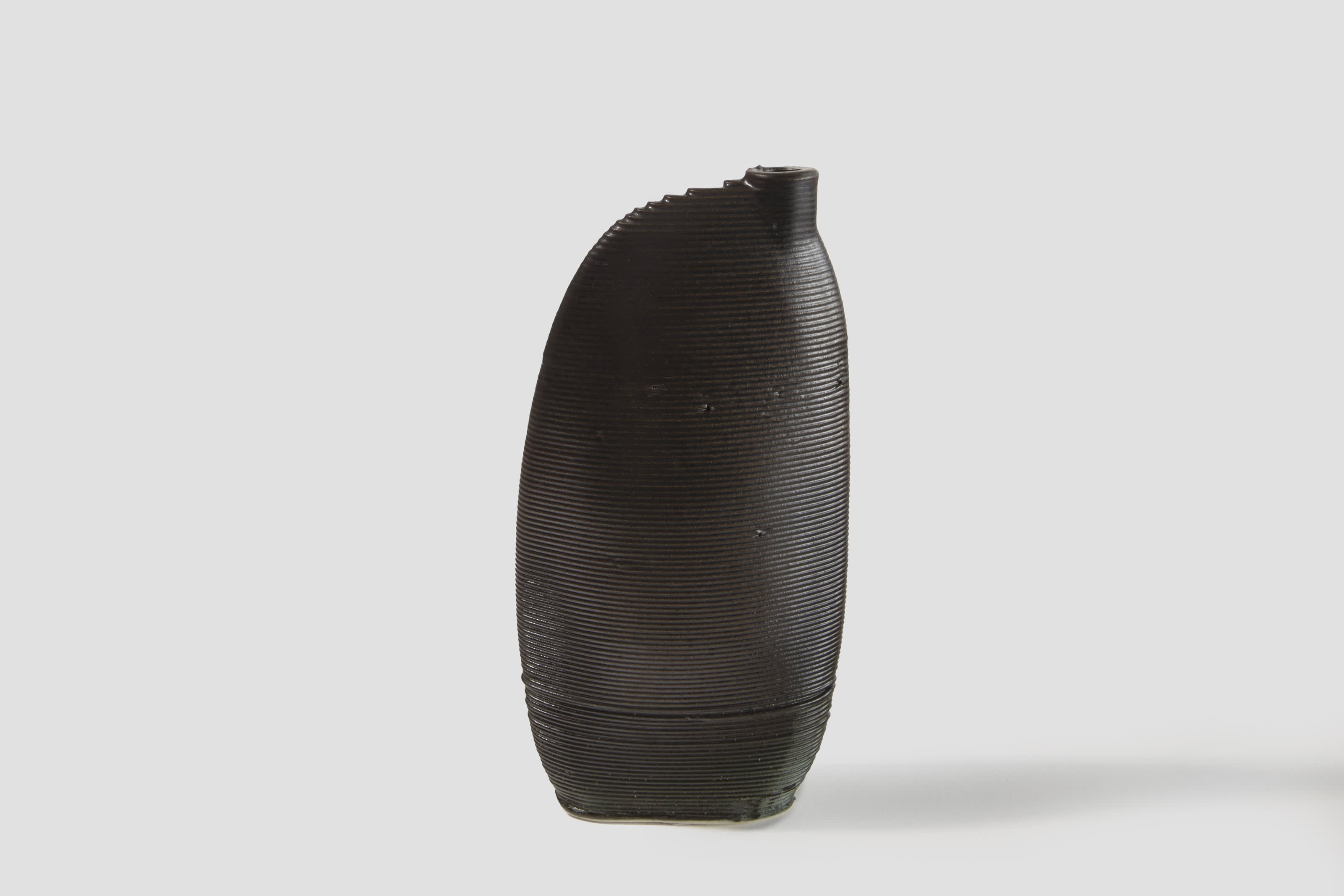
Encoded Stone Vessel, Berry Creek 5, 2021. 3-D printed ceramic and wildfire ash glaze, 9 x 4 x 1 in (22.9 x 10.2 x 2.5 cm).
Farber harnesses earth and heat in the hearth either constructed or out in the wild with gratitude for ‘clay as teacher, land as pedagogy, and fire as friend.’ When he digs up clay with his bare hands or forages feldspar or ash, he ponders the millennia that it took to shape the earth, the mineral, or the trees before incineration. There is childlike delight in the myriad possibilities of beauty in vitrification by fire—gleaming glaze, chalky sediment, curling flakes, cracks and fissures. Slabs or sherds, they are embodied meditations on what’s ineffable and seemingly unfathomable in deep time. Constantly attempting to grasp the reciprocity in what’s soldered as he stokes or tames fire, Farber has gathered a panoply of markings imprinted in the objects through which he has committed fire to memory.
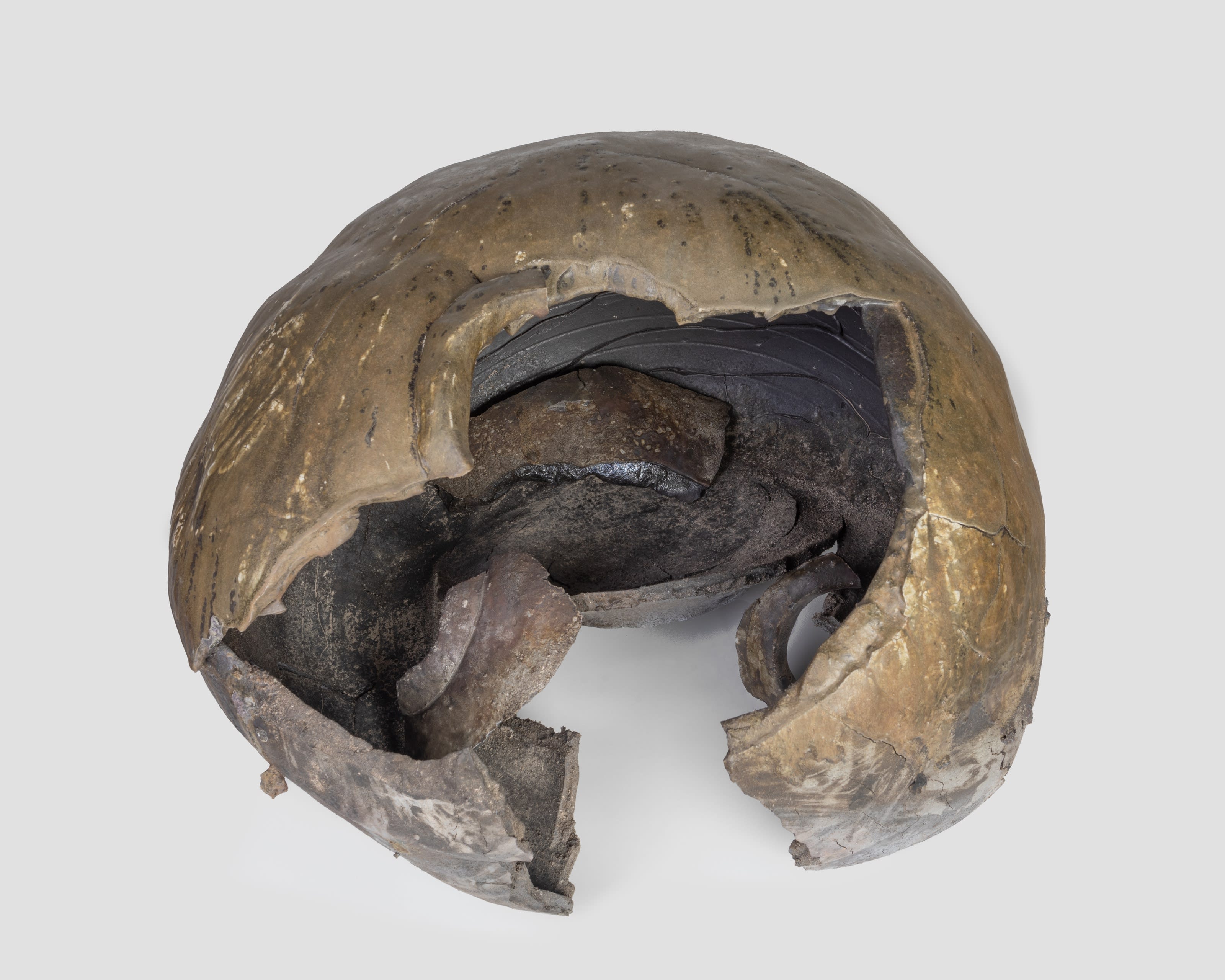
OPEN MOON, 2024, Wood-fired and hand-built black stoneware dug near Abiquiú, NM, 19 x 28 x 21 in (48.3 x 61 x 53.3 cm).
From the Hadean to the Anthropocene
SPENCER LINFORD
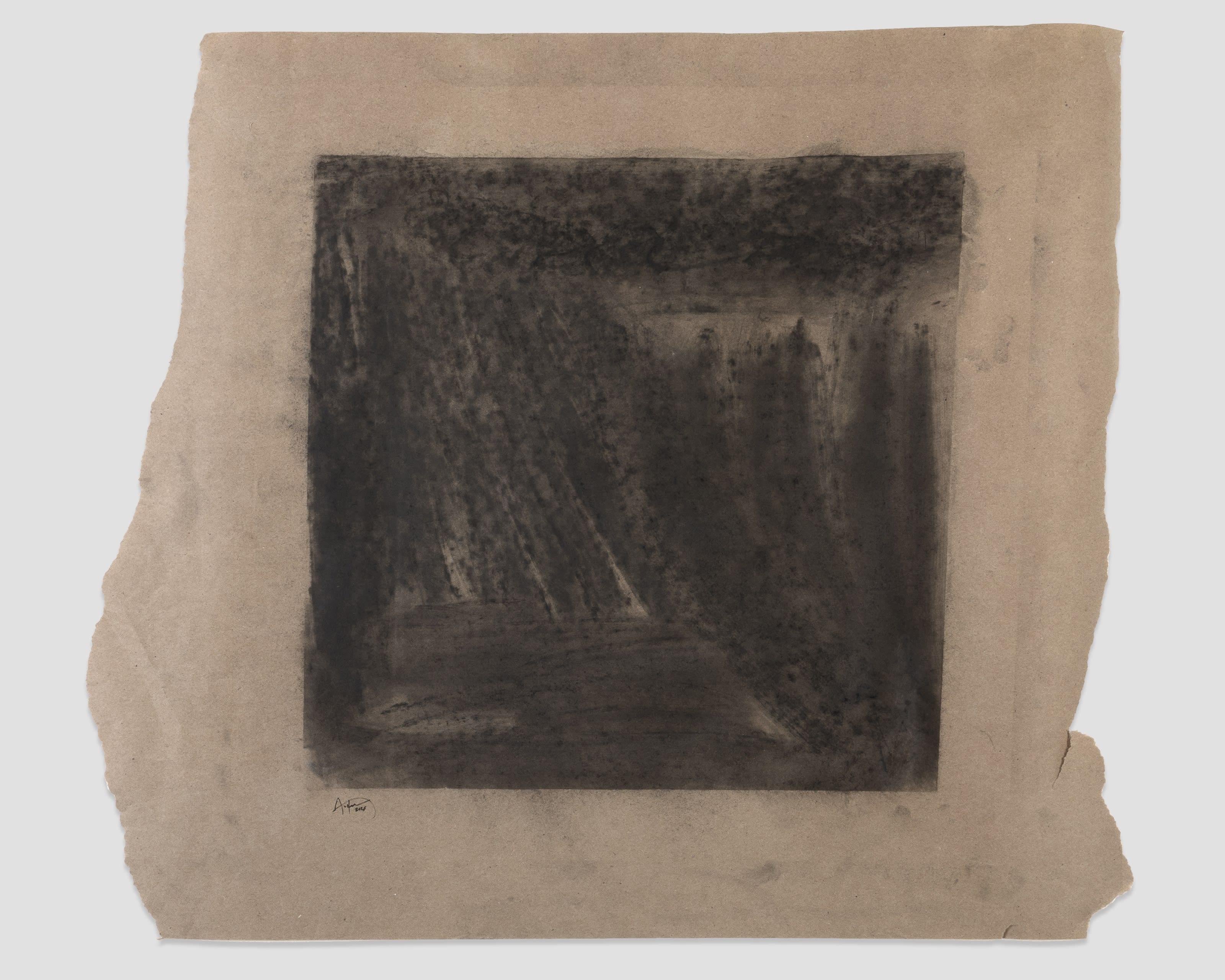
Markings from Fire – American Creek/Hermits Peak Wave 001, 2025. Wildfire charcoal on paper and charred tree branch, 18 x 19 in (45.7 x 48.3 cm).
It’s 4:00 a.m. Outside, the sky is black, as it is every day Farber prepares for work. Today, he has a 5:30 a.m. call time to hike into the Sangre de Cristo mountains. He has a 12-hour day ahead of him assessing hazard trees (burned trees) along powerlines. A physically demanding day; one of many that Farber will spend working to prevent future fires in Hermits Peak. Although three years have passed since the Calf Canyon/Hermits Peak Fire, burn areas are still recovering—and will be for a long time.
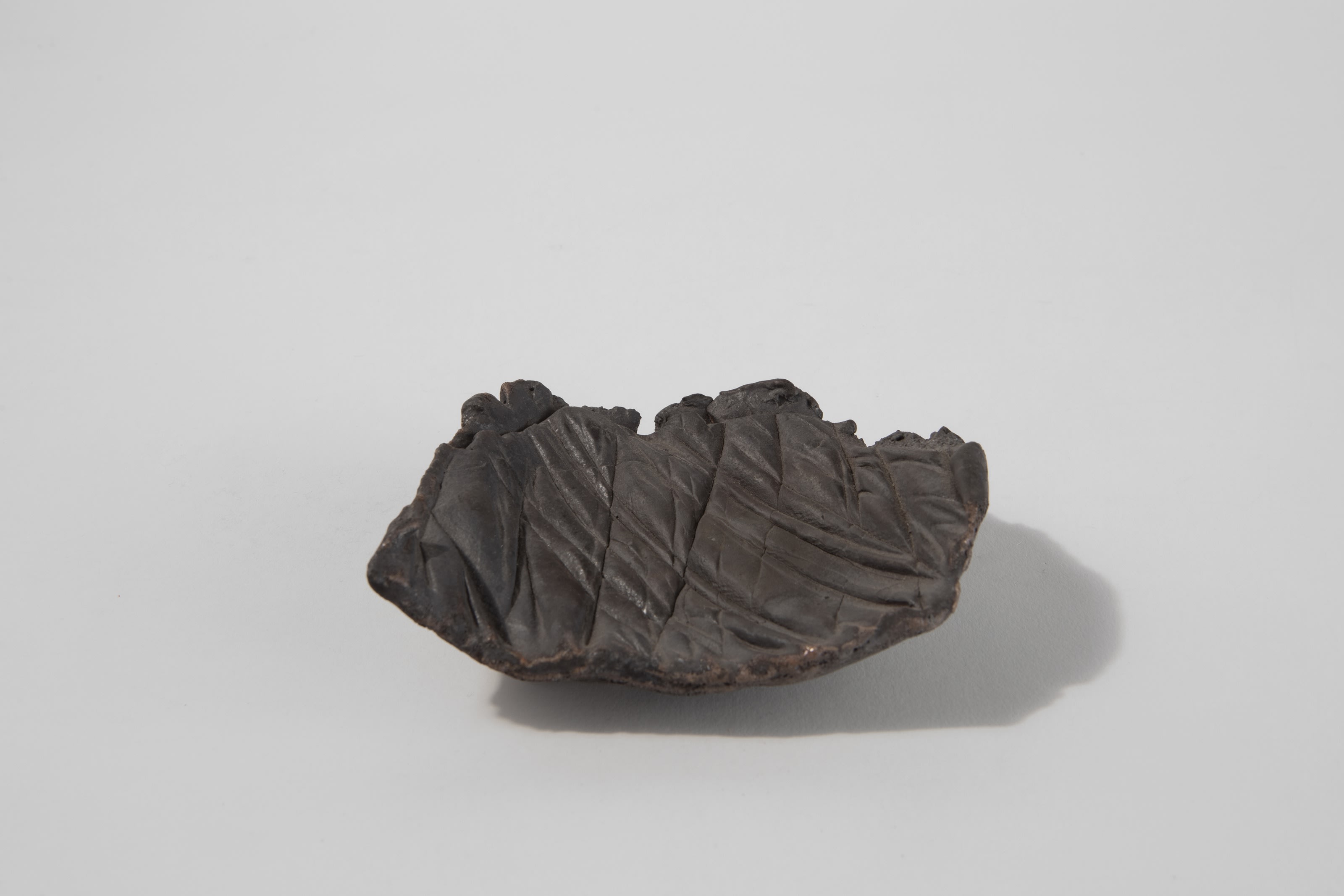
Chunk Maquette Abiquiú Black L03, 2024. Wood-fired ceramic, black stoneware dug near Abiquiú, NM, 1 x 5 x 5 in (2.5 x 12.7 x 12.7 cm).
Markings from Fire is a multimedia exhibition about our relationship to ecological cycles and broader geological time grounded in the deeply felt tragedy at Calf Canyon/Hermits Peak. We intuitively understand what fire is—useful, dangerous, beautiful—but it is difficult to grasp the transformative power of the chemical reaction unless you have experienced its impact. How then are we, the uninitiated, to understand fire?
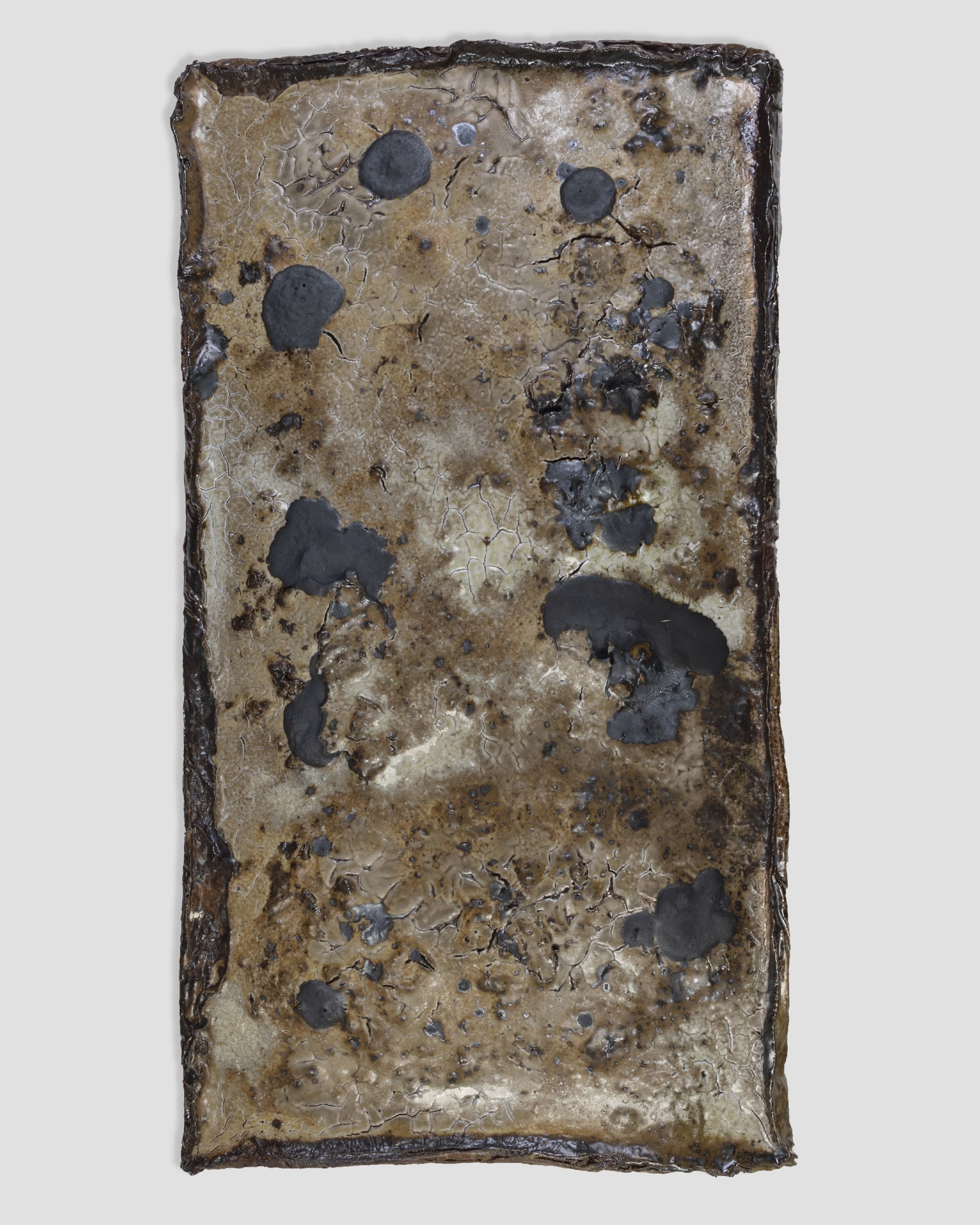
PANEL, 2025. Wood-fired ceramic, black stoneware dug near Abiquiú, NM, between 72 and 100 million years old; Ojo Caliente feldspar Shino glaze with minerals approximately 2.5 billion years old; iron melt inclusions; steel cleats, 36 x 21 x 2 in (91.4 x 53.3 x 5.1 cm).
Consider PANEL. It is earthy, natural, and seemingly chaotic. To achieve this deliberately random effect, Farber woodfires his clay works, allowing fire to impart its transformative beauty to the ancient sediments he gathers in and around Abiquiú, NM. The scars and cracks in the topography of PANEL recall the inhospitable landscapes of the Hadean Eon (approximately 4 billion years ago), when lava, heat, and unstable chemical reactions left Earth barren and lifeless. As if it were a vestigial incarnation of how geochronological events brought us to our ecological present, PANEL references a network of environmental interactions that support our biosphere, echoing the biological interactions that support the broader ecosystems of the Sangre de Cristo mountains or even the imperceptible convergences and divergences of tectonic plates that form the land masses on which we build our lives.
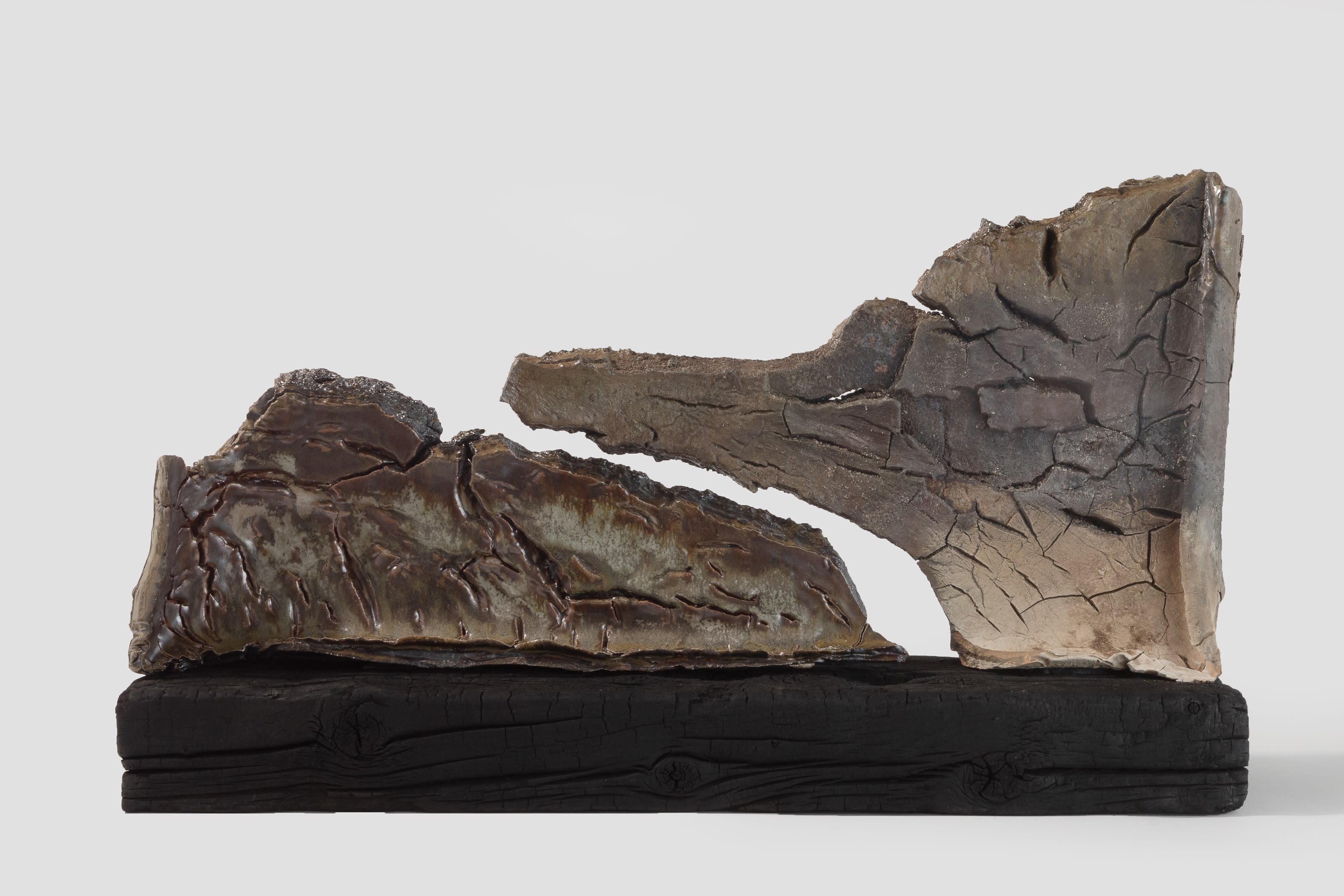
FIREBOX RIFT, 2025, Wood-fired ceramic, black stoneware dug near Abiquiú, NM, between 72 and 100 million years old; Ojo Caliente feldspar mineral glaze approximately 2.5 billion years old; Ponderosa Pine ash; charred beam base, 20 x 32 x 7 1/2 in (50.8 x 81.3 x 19.1 cm).
Consider FIREBOX RIFT. One can literally see what the sedimentology and composition of the work suggest: the separation of two tectonic plates—a divergence not unlike that which created the Rio Grande Rift, where cities like Taos, Abiquiú, and even Santa Fe sit. On a broad geologic scale, these cities are connected. Yet on a human scale, they feel distinct from one another. This disconnect in our perception of space is a function of our built environments and the lives we lead within them. The drive to meet what we have conditioned ourselves to believe as our hierarchy of needs leads us to form societies that seldom encourage us to consider the stars or our place in the universe. The psychological myopia that comes with this notion of self-preservation makes it difficult to wrap our heads around the abstract concepts that explain the interconnectedness of our universe, such as quantum entanglement, which Einstein summarized as “spooky action at a distance”—a sensation that must apply to the experience of wildfire. Our distance from fire’s impact is exactly why Farber’s documentary wildfire photography is powerful: it transports and connects us to places, experiences, and emotions we otherwise feel disconnected from. How else are we to learn what it means to live through something as devastating as the Calf Canyon/Hermits Peak Fire? Or more recently, the Palisades and Eaton Fires in Los Angeles, CA? How do we emerge from these events and learn how to adapt to our changed landscapes? How do we bear witness?
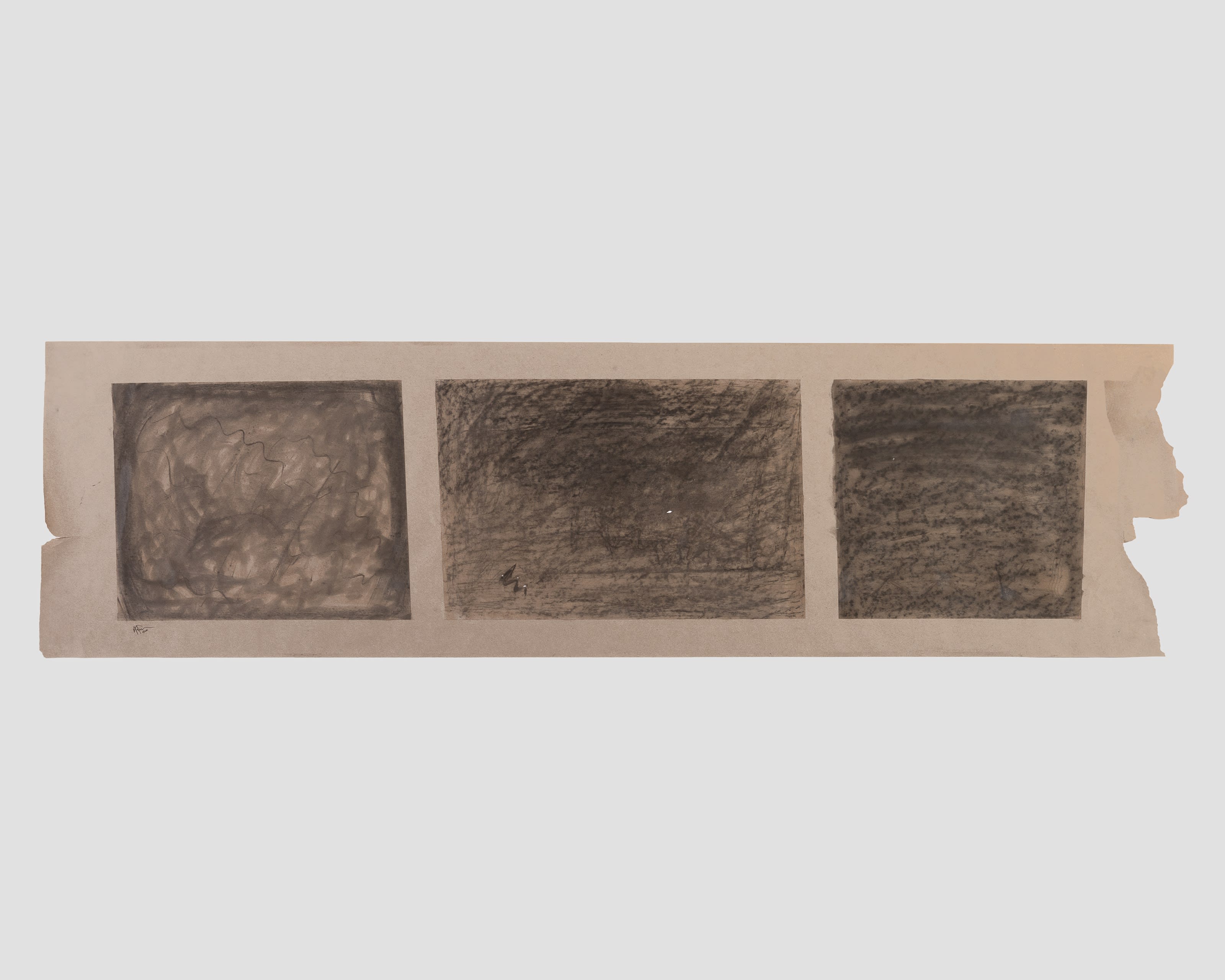
Markings from Fire – American Creek/Hermits Peak 003, 2025. Wildfire charcoal on paper and charred tree branch, 18 x 63 in (45.7 x 160 cm).
Finally, consider fire. Despite its capacity for destruction, fire is essential to healthy ecosystems in which it naturally occurs and is part of larger weather cycles that maintain long-term ecological homeostasis. Fire and its transformative power supports nature, much like it supports Farber’s larger sculptural contemplations of deep time, as can be seen in the artist’s shou sugi ban plinths, charred by fire for preservation. Unlike fires caused by phenomena like lightning, the Calf Canyon/Hermits Peak fire was not attributable to natural causes but rather human oversight. In our cosmically infinitesimal time on Earth, we humans have managed to disrupt the equilibrium of our collective home. Farber’s work, with its mindful use of fire and geological allusions, grounds us in the unfolding physical reality of the audacity and ambition with which we build our societies by bringing the home right beneath our feet to eye level.
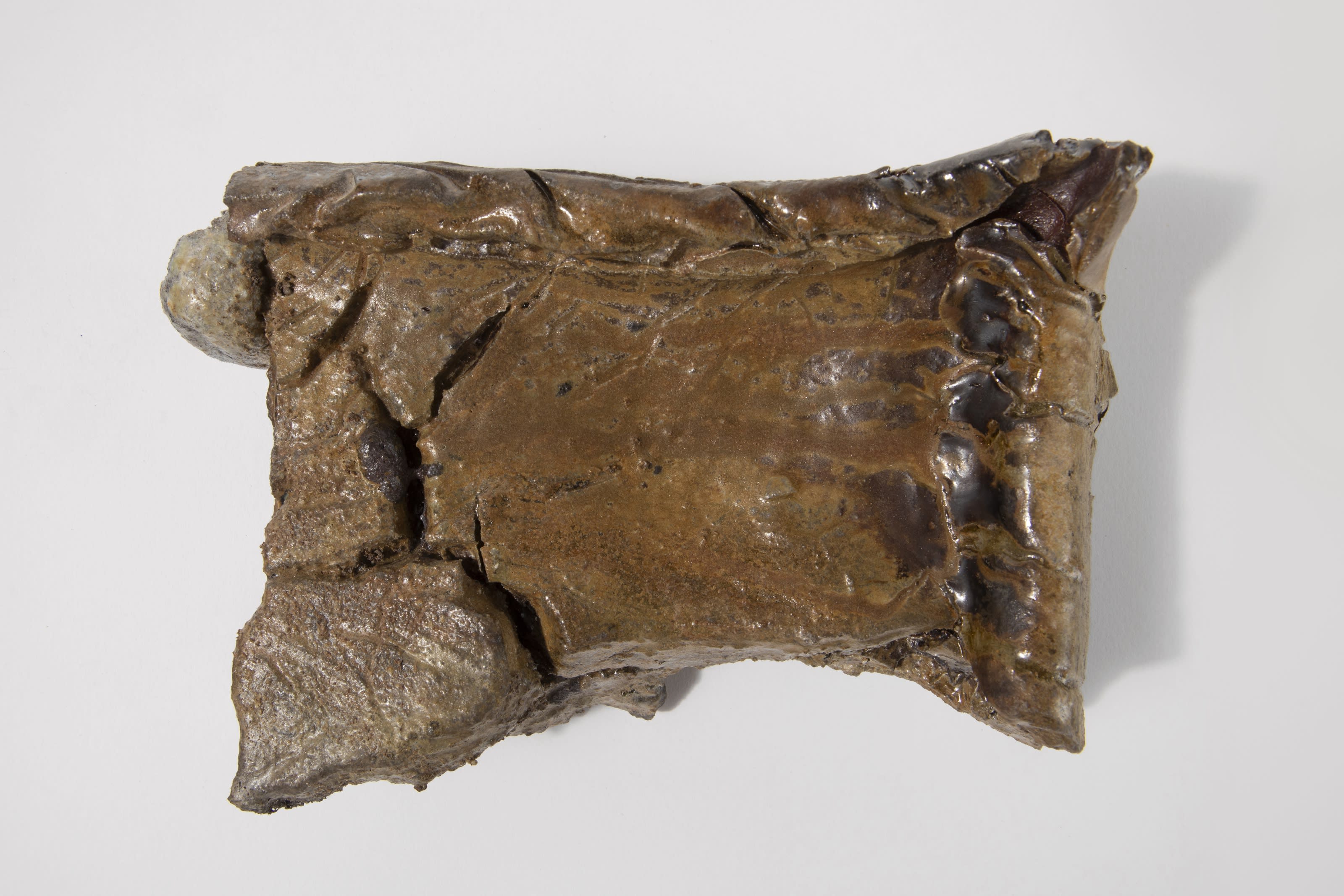
Chunk 3, 2025. Wood-fired ceramic black stoneware dug near Abiquiú, NM, between 72 and 100 million years old; Ponderosa Pine ash, 3 1/2 x 9 x 5 in (8.9 x 22.9 x 12.7 cm).
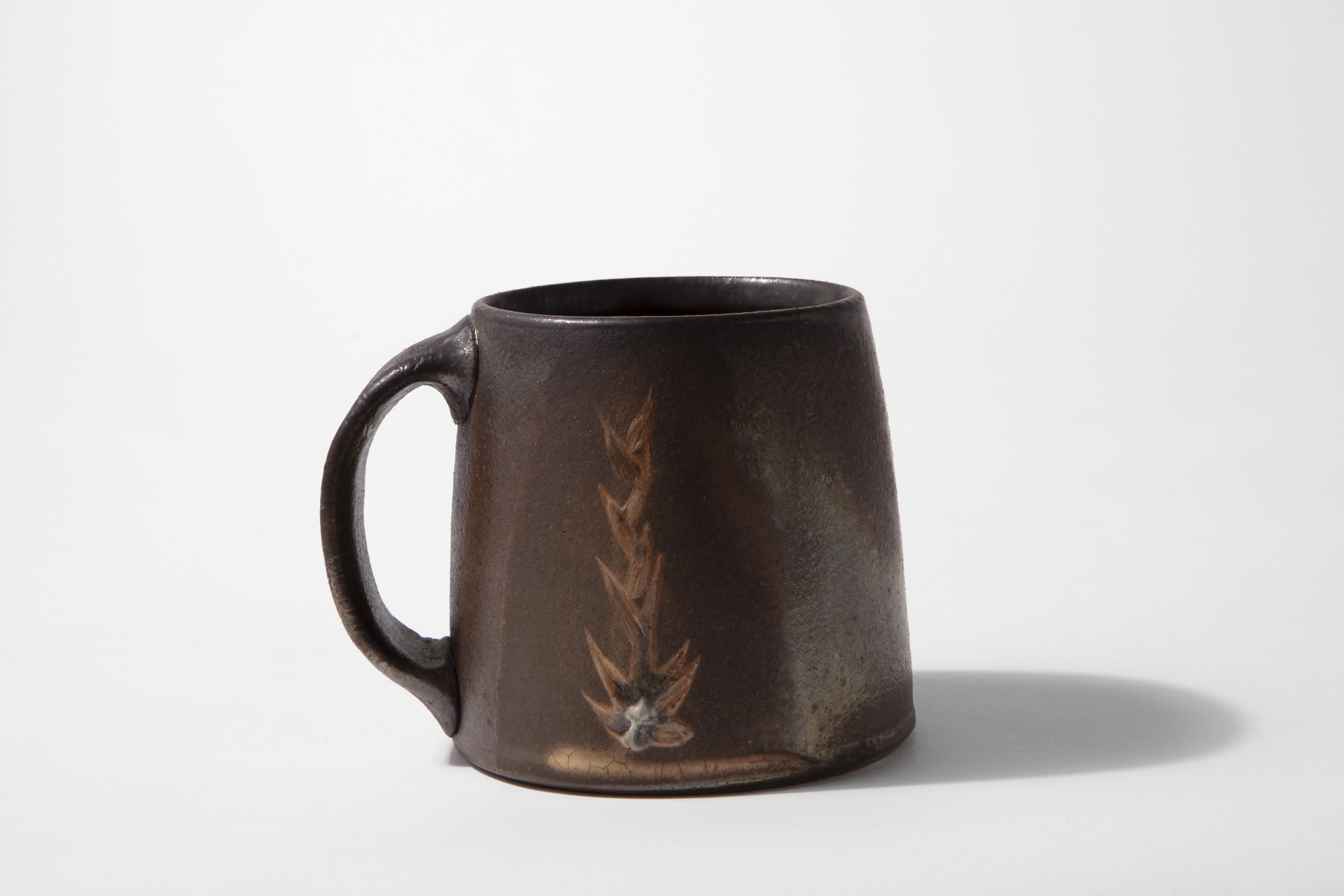
Abiquiú Clay Mug, 2025. Wood-fired ceramic , 4 x 4 x 4 in (10.2 x 10.2 x 10.2 cm).
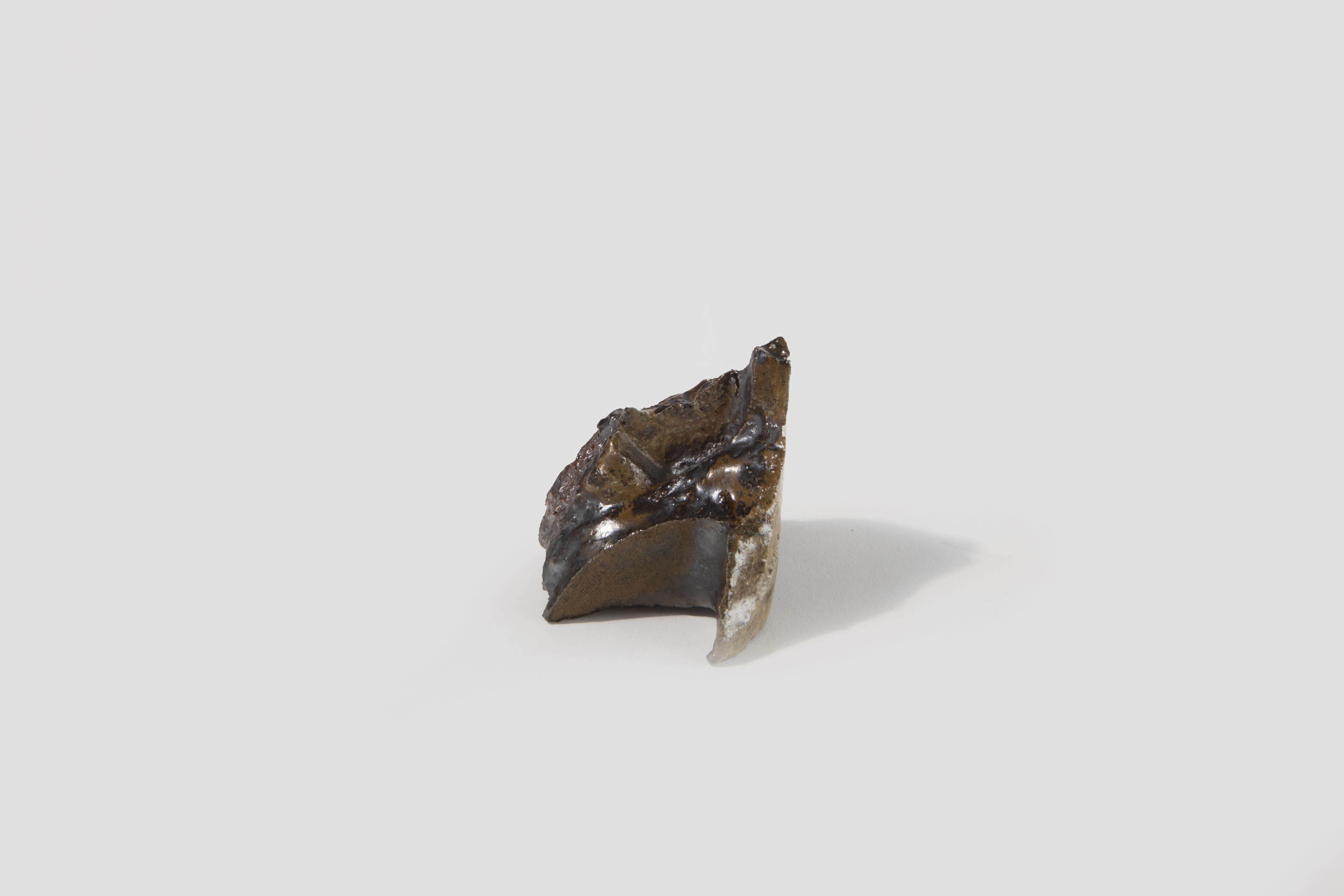
Chunk 5, 2025. Wood-fired ceramic black stoneware dug near Abiquiú, NM, between 72 and 100 million years old; Ponderosa Pine ash, 3 1/2 x 2 x 2 in (8.9 x 5.1 x 5.1 cm).
SEE ALL WORKS
Photos by Molly Wagoner, courtesy of form & concept